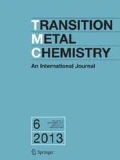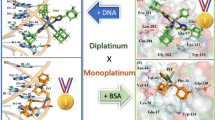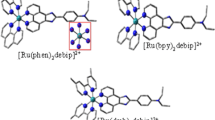Abstract
Two ruthenium(II) complexes [RuIICl(PPh3)2(L)] (1) and [RuII(L)2] (2) were synthesized by reacting [RuCl2(PPh3)3] and thiophene-2-carboxylic acid (1-pyridine-2-yl-ethylidene)-hydrazide (HL) in methanol–chloroform, and characterized by elemental analysis and spectral and XRD data. The ratio of ligand to metal is 1:1 in the former complex and 2:1 in the latter. Interaction of these complexes with CT-DNA was studied using absorption and emission spectral studies; these show that both the complexes interact with CT-DNA through intercalative modes of interaction. Their BSA-binding activity results indicated the operation of static quenching mechanism and stronger binding of tryptophan residues than tyrosine residues. In vitro cytotoxicity assays against HeLa and MCF-7 cell lines showed better activity of both the complexes compared to the standard drug cisplatin. Overall, the activity of complex 2 with two units of coordinated ligand showed better activity than the other one.
Graphical abstract











Similar content being viewed by others
References
Guo Z, Sadler PJ (1999) Metals in medicine. Angew Chem Int Ed 38(11):1512–1531
Da Silva JF, Williams RJ (2001) The biological chemistry of the elements: the inorganic chemistry of life. Oxford University Press, Oxford
Tang B, Wan D, Lai SH, Yang HH, Zhang C, Wang XZ, Zeng CC, Liu YJ (2017) Design, synthesis and evaluation of anticancer activity of ruthenium (II) polypyridyl complexes. J Inorg Biochem 173:93–104
Bergamo A, Dyson PJ, Sava G (2018) The mechanism of tumour cell death by metal-based anticancer drugs is not only a matter of DNA interactions. Coordn Chem Rev 360:17–33
Eswaran J, Sivalingam K, Viswanatha VP, Nattamai SB, Nallasamy D (2015) Synthesis, characterization, DNA/protein binding and in vitro cytotoxic evaluation of new Ru (III) complexes containing aroylhydrazone ligands: does hydrogen bonding influence the coordination behavior of hydrazones? Inorg Chim Acta 429:148–159
Jayanthi E, Kalaiselvi S, Padma VV, Bhuvanesh NS, Dharmaraj N (2016) Solvent assisted formation of ruthenium (III) and ruthenium (II) hydrazone complexes in one-pot with potential in vitro cytotoxicity and enhanced LDH, NO and ROS release. Dalton Trans 45(4):1693–1707
Oun R, Moussa YE, Wheate NJ (2018) The side effects of platinum-based chemotherapy drugs: a review for chemists. Dalton Trans 47(19):6645–6653
Wlodarczyk MT, Dragulska SA, Camacho-Vanegas O, Dottino PR, Jarzęcki AA, Martignetti JA, Mieszawska AJ (2018) Platinum (II) complex-nuclear localization sequence peptide hybrid for overcoming platinum resistance in cancer therapy. ACS Biomater Sci Eng 4(2):463–467
Liu W, Gust R (2013) Metal N-heterocyclic carbene complexes as potential antitumor metallodrugs. Chem Soc Rev 42(2):755–773
Kelland LR (2000) Preclinical perspectives on platinum resistance. Drugs 59(4):1–8
Hartinger CG, Dyson PJ (2009) Bioorganometallic chemistry—from teaching paradigms to medicinal applications. Chem Soc Rev 38(2):391–401
Chen J, Luo Z, Zhao Z, Xie L, Zheng W, Chen T (2015) Cellular localization of iron (II) polypyridyl complexes determines their anticancer action mechanisms. Biomaterials 71:168–177
Antonarakis ES, Emadi A (2010) Ruthenium-based chemotherapeutics: are they ready for prime time? Can Chemother Pharmacol 66(1):1–9
Tian Z, Li J, Zhang S, Xu Z, Yang Y, Kong D, Zhang H, Ge X, Zhang J, Liu Z (2018) Lysosome-targeted chemotherapeutics: half-sandwich ruthenium (II) complexes that are selectively toxic to cancer cells. Inorg Chem 57(17):10498–10502
He Q, Liang CH, Lippard SJ (2000) Steroid hormones induce HMG1 overexpression and sensitize breast cancer cells to cisplatin and carboplatin. Proc Natl Acad Sci USA 97(11):5768–5772
Cassells I, Stringer T, Hutton AT, Prince S, Smith GS (2018) Impact of various lipophilic substituents on ruthenium (II), rhodium (III) and iridium (III) salicylaldimine-based complexes: synthesis, in vitro cytotoxicity studies and DNA interactions. J Biol Inorg Chem 23:1–2
Tang B, Bing JH, Wan D, Lai SH, Wang XZ, Zhang C, Zeng CC, Liu YJ (2017) Synthesis, biological activities studies of ruthenium(II) polypyridyl complexes. Transit Met Chem 42:373–386
Du Y, Chen W, Fu X, Deng H, Deng J (2016) Synthesis and biological evaluation of heterocyclic hydrazone transition metal complexes as potential anticancer agents. RSC Adv 6(111):109718–109725
Kokare DG, Naik K, Nevrekar A, Kotian A, Kamat V, Revankar VK (2016) Synthesis and spectroscopic characterization of transition metal complexes derived from novel benzofuran hydrazone chelating ligand: DNA cleavage studies and antimicrobial activity with special emphasis on antituberculosis. Appl Organomet Chem 30(4):181–187
Soliman SM, Albering JH, Farooq M, Wadaan MA, El-Faham A (2017) Synthesis, structural and biological studies of two new Co (III) complexes with tridentate hydrazone ligand derived from the antihypertensive drug hydralazine. Inorg Chim Acta 466:16–29
Haas KL, Franz KJ (2009) Application of metal coordination chemistry to explore and manipulate cell biology. Chem Rev 109(10):4921–4960
Wan D, Lai SH, Zeng CC, Zhang C, Tang B, Liu YJ (2017) Ruthenium(II) polypyridyl complexes: synthesis, characterization and anticancer activity studies on BEL-7402 cells. J Inorg Biochem 173:1–11
Meggers E, Atilla-Gokcumen GE, Gründler K, Frias C, Prokop A (2009) Inert ruthenium half-sandwich complexes with anticancer activity. Dalton Trans 48:10882–10888
Williams DS, Atilla GE, Bregman H, Arzoumanian A, Klein PS, Meggers E (2005) Switching on a signaling pathway with an organoruthenium complex. Angew Chem 117(13):2020–2023
Aboafia SA, Elsayed SA, El-Sayed AK, El-Hendawy AM (2018) New transition metal complexes of 2, 4-dihydroxybenzaldehyde benzoylhydrazone Schiff base (H2dhbh): synthesis, spectroscopic characterization, DNA binding/cleavage and antioxidant activity. J Mol Struct 1158:39–50
Krishnamoorthy P, Sathyadevi P, Senthilkumar K, Muthiah PT, Ramesh R, Dharmaraj N (2011) Copper (I) hydrazone complexes: synthesis, structure, DNA binding, radical scavenging and computational studies. Inorg Chem Commun 14(9):1318–1322
Sathyadevi P, Krishnamoorthy P, Alagesan M, Thanigaimani K, Muthiah PT, Dharmaraj N (2012) Synthesis, crystal structure, electrochemistry and studies on protein binding, antioxidant and biocidal activities of Ni (II) and Co (II) hydrazone complexes. Polyhedron 31(1):294–306
Mohanraj M, Ayyannan G, Raja G, Jayabalakrishnan C (2016) Ruthenium (II) complexes containing 4-methoxybenzhydrazone ligands: synthesis, characterization, DNA binding, DNA cleavage, radical scavenging and in vitro cytotoxic activity. Appl Organomet Chem 30(7):550–560
Young DW (1975) Heterocyclic chemistry, 1st edn. Longman group Ltd., London
La Placa SJ, Ibers JA (1965) A five-coordinated d6 complex: structure of dichlorotris (triphenylphosphine) ruthenium (II). Inorg Chem 4(6):778–783
APEX2 Program for data collection, integration on area detectors. BRUKER AXS Inc., Madison
Sheldrick GM (2008) SADABS, Program for absorption correction of area detector frames. BRUKER AXS Inc., Madison
Sheldrick GM (2015) Crystal structure refinement with SHELXL. Acta Crystallogr Sect C Struct Chem 71(1):3–8
Dolomanov OV, Bourhis LJ, Gildea RJ, Howard JAK, Puschmann H (2009) OLEX2: a complete structure solution, refinement and analysis program. J Appl Cryst 42:339–350
Marmur J (1961) A procedure for the isolation of deoxyribonucleic acid from micro-organisms. J Mol Biol 3(2):208–IN1
Reichmann ME, Rice SA, Thomas CA, Doty P (1954) A further examination of the molecular weight and size of desoxypentose nucleic acid. J Am Chem Soc 76(11):3047–3053
Lee M, Rhodes AL, Wyatt MD, Forrow S, Hartley JA (1993) GC base sequence recognition by oligoimidazolecarboxamide and C-terminus-modified analogs of distamycin deduced from circular dichroism, proton nuclear magnetic resonance, and methidiumpropylethylenediaminetetraacetate-iron(II) footprinting studies. Biochemistry 32(16):4237–4245
Sathyadevi P, Krishnamoorthy P, Butorac RR, Cowley AH, Dharmaraj N (2012) Synthesis of novel heterobimetallic copper (I) hydrazone Schiff base complexes: a comparative study on the effect of heterocyclic hydrazides towards interaction with DNA/protein, free radical scavenging and cytotoxicity. Metallomics 4(5):498–511
Rajput C, Rutkaite Ramune, Swanson Linda, Haq Ihtshamul, Thomas Jim A (2006) Dinuclear monointercalating RuII complexes that display high affinity binding to duplex and quadruplex DNA. Chem Eur J 17:4611–4619
Selvakumaran N, Bhuvanesh NSP, Karvembu R (2014) Self-assembled Cu(II) and Ni(II) metallamacrocycles formed from 3,3,3′,3′-tetrabenzyl-1,1′-aroylbis (thiourea) ligands: DNA and protein binding studies, and cytotoxicity of trinuclear complexes. Dalton Trans 43:16395–16410
Valeur B, Berberan-Santos MN (2012) Molecular fluorescence: principles and applications. Wiley, New York
Alagesan M, Bhuvanesh NS, Dharmaraj N (2013) Potentially cytotoxic new copper (II) hydrazone complexes: synthesis, crystal structure and biological properties. Dalton Trans 42(19):7210–7223
Lo KK, Tsang KH, Hui WK, Zhu N (2005) Design of Rhenium(I) polypyridine biotin complexes as a new class of luminescent probes for avidin. Inorg Chem 44:1992–2002
Kumar GP, Navya K, Ramya EM, Venkataramana M, Anand T, Anilakumar KR (2013) DNA damage protecting and free radical scavenging properties of Terminalia arjuna bark in PC-12 cells and plasmid DNA. Free Radic Antioxid 3(1):35–39
Sathyadevi P, Krishnamoorthy P, Bhuvanesh NS, Kalaiselvi P, Padma VV, Dharmaraj N (2012) Organometallic ruthenium (II) complexes: synthesis, structure and influence of substitution at azomethine carbon towards DNA/BSA binding, radical scavenging and cytotoxicity. Eur J Med Chem 55:420–431
Chohan ZH, Farooq MA, Scozzafava A, Supuran CT (2002) Antibacterial schiff bases of oxalyl-hydrazine/diamide incorporating pyrrolyl and salicylyl moieties and of their zinc (II) complexes. J Enz Inhib Med Chem 17(1):1–7
Raveendran R, Pal S (2005) Some trans-chlorobis (triphenylphosphine) ruthenium (II) complexes with N, N, O-donor N-(aroyl)-N′-(picolinylidene) hydrazines. Polyhedron 24(1):57–63
Pal S, Pal S (2003) Syntheses, structures and properties of trans-dichlororuthenium (II) complexes with N 4-donor Schiff bases. Polyhedron 22(6):867–873
Ortiz-Frade LA, Ruiz-Ramírez L, González I, Marín-Becerra A, Alcarazo M, Alvarado-Rodriguez JG, Moreno-Esparza R (2003) Synthesis and spectroelectrochemical studies of mixed heteroleptic chelate complexes of ruthenium (II) with 1, 8-bis (2-pyridyl)-3, 6-dithiaoctane (pdto) and substituted 1, 10-phenanthrolines. Inorg Chem 42(6):1825–1834
Lai CY, Mak WL, Chan EY, Sau YK, Zhang QF, Lo SM, Williams ID, Leung WH (2003) Ruthenium complexes with chiral tetradentate imino–sulfoxide ligands. Inorg Chem 42(19):5863–5870
Sirajuddin M, Ali S, Badshah A (2013) Drug–DNA interactions and their study by UV–Visible, fluorescence spectroscopies and cyclic voltametry. J Photochem Photobiol 124:1–9
Hu K, Li F, Zhang Z, Liang F (2017) Synthesis of two potential anticancer copper (II) complex drugs: their crystal structure, human serum albumin/DNA binding and anticancer mechanism. New J Chem 41(5):2062–2072
Wolfe A, Shimer GH Jr, Meehan T (1987) Polycyclic aromatic hydrocarbons physically intercalate into duplex regions of denatured DNA. Biochemistry 26(20):6392–6396
Saeed HK, Saeed IQ, Buurma NJ, Thomas JA (2017) The structure of linkers affects the DNA binding properties of tethered dinuclear ruthenium (II) metallo-intercalators. Chem Eur J 23:5467–5477
Kalaiarasi G, Jain R, Puschman H, Chandrika SP, Preethi K, Prabhakaran R (2017) New binuclear Ni (II) metallates containing ONS chelators: synthesis, characterisation, DNA binding, DNA cleavage, protein binding, antioxidant activity, antimicrobial and in vitro cytotoxicity. New J Chem 41(7):2543–2560
Ramadevi P, Singh R, Jana SS, Devkar R, Chakraborty D (2017) Mixed ligand ruthenium arene complexes containing N-ferrocenyl amino acids: biomolecular interactions and cytotoxicity against MCF7 cell line. J Organomet Chem 833:80–87
Lazić D, Arsenijević A, Puchta R, Bugarčić ŽD, Rilak A (2016) DNA binding properties, histidine interaction and cytotoxicity studies of water soluble ruthenium (II) terpyridine complexes. Dalton Trans 45(11):4633–4646
Jayanthi E, Venkataramana M, Neethu S, Bhuvanesh NS, Dharmaraj N (2017) Biomolecular interaction and in vitro cytotoxicity of ruthenium complexes containing heterocyclic hydrazone. Is methanol a non-innocent solvent to influence the oxidation state of the metal and ligation of hydrazone? Polyhedron 132:39–52
Suh D, Jonathan BC (1995) Criteria for the mode of binding of DNA binding agents. Bioorganic Med Chem 6:723–728
Butour J-L, Jean-Pierre M (1981) Viscosity, nicking, thermal and alkaline denaturation studies on three classes of DNA-platinum complex. Biochimica et Biophysica Acta (BBA)-Nucl Acids Protein Synth 3:305–315
Shilpa M, Shobha Devi C, Nagababu P, Naveena Lavanya Latha J, Ramjee P, Venkateshwara Rao J, Aravind K, Satyanarayana S (2013) Ruthenium(II) ethylenediamine complexes with dipyridophenazine ligands: synthesis, characterization, DNA interactions, and antiproliferative activities. J Coord Chem 10:1661–1675
Shaikh SM, Seetharamappa J, Ashoka S, Kandagal PB (2007) A study of the interaction between bromopyrogallol red and bovine serum albumin by spectroscopic methods. Dyes Pigm 73(2):211–216
Karami K, Hashemi S, Lipkowski J, Mardani F, Momtazi-borojeni AA, Lighvan ZM (2017) Synthesis, characterization and biological activities of two novel orthopalladated complexes: interactions with DNA and bovine serum albumin, antitumour activity and molecular docking studies. Appl Organomet Chem 31(10):3740–3756
Muralisankar M, Haribabu J, Bhuvanesh NS, Karvembu R, Sreekanth A (2016) Synthesis, X-ray crystal structure, DNA/protein binding, DNA cleavage and cytotoxicity studies of N (4) substituted thiosemicarbazone based copper (II)/nickel (II) complexes. Inorg Chim Acta 449:82–95
Eswaran R, Bertani R, Sgarbossa P, Karuppannan N (2016) Synthesis, crystal structure, DNA and protein binding studies of novel binuclear Pd (II) complex of 6-methoxy-2-oxo-1, 2-dihydroquinoline-3-carbaldehyde-4 (N, N)-dimethylthiosemicarbazone. J Inorg Biochem 155:1–8
Miller JN (1979) Recent advances in molecular luminescence analysis. Proc Anal Div Chem Soc 16:203–208
Momen-Heravi M, Chamani J (2012) The investigation of the interaction between human serum transferring with colchicine in the presence of Pb+2 ions: Synchronous fluorescence measurements. J Chem Health Risks 1(2):13–15
Raja DS, Paramaguru G, Bhuvanesh NS, Reibenspies JH, Renganathan R, Natarajan K (2011) Effect of terminal N-substitution in 2-oxo-1, 2-dihydroquinoline-3-carbaldehyde thiosemicarbazones on the mode of coordination, structure, interaction with protein, radical scavenging and cytotoxic activity of copper (II) complexes. Dalton Trans 40(17):4548–4559
Acknowledgements
We would like to acknowledge University Grants Commission (UGC) for the award of Basic Scientific Research fellowship to one of the authors (S. N) (Grant No. F.25-1/2014-15(BSR)7-26/2007/(BSR); dt: 05.11.2015).
Author information
Authors and Affiliations
Corresponding author
Additional information
Publisher's Note
Springer Nature remains neutral with regard to jurisdictional claims in published maps and institutional affiliations.
Electronic supplementary material
Below is the link to the electronic supplementary material.
Rights and permissions
About this article
Cite this article
Eswaran, J., Sankar, N.K., Bhuvanesh, N.S.P. et al. Ruthenium hydrazone complexes with 1:1 and 1:2 metal–ligand stoichiometry: a comparison of biomolecular interactions and in vitro cytotoxicities. Transit Met Chem 44, 369–382 (2019). https://doi.org/10.1007/s11243-018-00303-1
Received:
Accepted:
Published:
Issue Date:
DOI: https://doi.org/10.1007/s11243-018-00303-1




